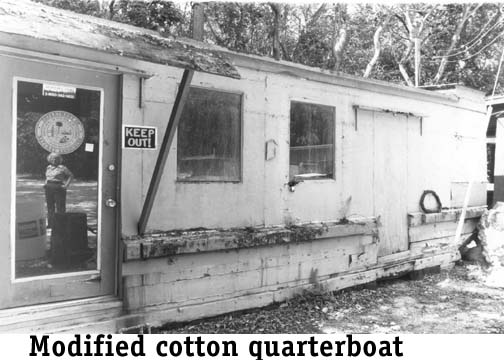|
COTTON GANGS By Jerry Wilkinson |
 |
|
COTTON GANGS By Jerry Wilkinson |
 |
|
Cotton harvesting in the Upper Keys is not something we normally think
of doing; however, it did occur in the 1930s. It was all harvesting though
- no planting! The Key West Citizen, dated November 21, 1935 reported:
“A small group of WPA workers was employed yesterday and today on
the eradication of the wild cotton growths in Monroe County. . . . Within
the next few days 20 other workers will be assigned to the project at Tavernier
and 20 at Key Largo.”
The WPA is the Works Progress Administration created in 1934 by President Franklin Roosevelt to provide jobs during the Great Depression. He had other work programs also like the Civilian Conservation Corps (CCC) where younger men did conservation project. Many public parks and other projects were made by these men. Later in 1934, another program called the Federal Emergency Relief Administration (FERA) sent World War One veterans to the Upper Keys to build highway bridges. Many were killed in the 1935 Hurricane. (See web page for the Hurricane Memorial.) The overall program was labeled The New Deal. There appear to be two reasons for the harvesting. One was the belief that the "boll weevil" wintered in the Keys and then would swoop up to Georgia, Alabama and Mississippi to ravage the cotton fields. Another reason was that the Keys could provide a stepping stone for the Caribbean island "pink boll worm" to migrate north to the U. S. cotton fields. The boll weevil originally entered the U.S. by crossing the Rio Grande River in about 1892 and rapidly spread throughout southern Texas. By 1922 it had infected 85 percent of the cotton belt. The cotton bolls were punctured by the insects and their eggs laid inside. Within a week, the eggs hatched into grubs which fed from the inside first and on to the outside in its pupae stage. The entire cycle from egg to adult is about three weeks so as many as seven generations are possible in a single growing season. The grub-punctured cotton boll will either shed or not mature properly.
Cotton is a warm weather plant and loves sunshine. It is grown in areas
with more than 200 days free of frost and with a temperature of 70 degrees
or more for the most part of that period. The cotton in the Keys is the Wild or Sea Island cotton and is the prehistoric ancestor of our domestic cotton, but of an inferior quality for commercial use. Wild cotton cannot be spun. It is a scrub, but grows to as much as 12 feet in height. Just how this cotton got here originally is speculation, but some think that it was brought over from the Bahamas. It was known that it was the cold that killed the U.S. cotton plants and that the Keys did not have that severe of cold weather. The Keys’ cotton grew all year long for years without dying and matured into huge scrubs or trees. This gave rise to the concern of the boll weevil, as it would have a perpetual home in the Keys. In 1932, the pink boll worm was found in south Florida. In 1933 under the Roosevelt Administration, the federal government undertook the annihilation of cotton in the Upper Keys. Documentation of the work can be obtained from the Florida WPA files. The Key West Citizen announced the Keys project in their November 21, 1935 issue "Eradicating Wild Cotton Growths - Small Group of Workers Were Employed Yesterday and Today." Much of the Keys and south Florida was wilderness. There were few if any roads, but the Keys were generally accessible by water. Similarly to Henry Flagler, they utilized quarterboats as work crew quarters. These were living quarters built on available used river barges. The one above was converted into an office, then a storage area and finally disposed of. This work was done very seriously and with great care. Captain Cliff Carpenter of Tavernier said each crew consisted of one white supervisor and seven or eight black workers with machetes. Mrs. Laurette (Pinder) Russell of Islamorada recalls how her father, Preston Pinder, was one of the "Cotton Gang" supervisors. The late Roger Albury of Tavernier was another supervisor. They actually stretched strings for straight paths across the island to form grids. Paths were then cut perpendicularly for a checkerboard effect. The "Cotton Gangs" would systematically follow the crisscross grid of paths removing every cotton plant, roots included. The plants were hauled into clearings where they were burned. Captain Cliff said the work went on for years and resulted in the almost complete annihilation of rattlesnakes also. One of the Cotton Gang crew boats was used as office space at Pennekamp Park until recently. Miss Lamar Louis Curry of Coral Gables recalled how she and her friends could easily walk the cotton paths from bay to ocean on her property at MM 97 and of the apparent eradication of the rattlesnake. She also told how oil exploration crews later used these paths for their seismological work on Key Largo. Ironically, supposedly as a result of the extermination effort, Wild Cotton, Gossypium hirsutum, is now on the endangered species list. For anyone wishing to see the plant, there is a small growth of wild cotton shrubs in front of the Keys’ Jewish Community Center at MM 93.5 oceanside. They are about 4-5 feet high growing between the decorator palms along the bike path, and their blooms are a beautiful light yellow. -----End----- Return to General History Index |
